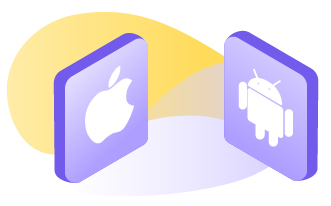Intro
All the startupers have one major thing in common — they do what they do to make this world a better place through innovation. To give that innovation a certain form so that the public could use it, modern entrepreneurs most frequently choose to put it inside a software, with the prevalence of mobile apps. Software development industry with its rapid pace and high cash flow is a truly welcoming environment for new ideas and changes. However, this doesn’t mean tech startups never struggle on their way to recognition. Lack of finance, low technical expertise, team shortage, and of course lack of understanding and faith in the product you’re trying to create — even one of these things is a bit of a challenge to handle. This article is going to explore why some app startups succeed while others fail and what are the steps to go through on the way of your startup becoming a corporation.
App-Based Startup: Steps To Follow
#1. Validate your idea

Any startup regardless of the area comes out of an idea. Before signing a contract with a software development company or hiring a full-time team to build the project, stop for a second and think whether your app is worth building at all. Regardless of you doubting the value of your idea or standing still on it, the following set of questions is a must to answer at the very beginning of your journey:
- What problem will my app solve?
- Has this problem ever been addressed before?
- Who is your target audience? (Hint: everyone on Earth is the wrong answer.)
- How do people deal with that problem now?
- How is your solution better than the matters people have been using so far?
The answers to all of these questions have to be simple and straightforward. If it takes you more than a few words to cover each of them — your idea is too raw yet and has to be polished.
#2. Choose the platform

Almost unexceptionally, big tech corporations run their apps on web, iOS, Android and even platforms we haven’t heard about in years, like Symbian or Windows Phone OS. That way, they cover the biggest amount of users allowing them to install and use their software products. You’ll hear advice on making your initial launch multi-platform a lot. However, our background in custom software development for startups proved ineffectiveness of such a strategy. Instead of trying to maneuver your to-be application on multiple platforms simultaneously, we recommend you analyze your target audience first and choose between two market titans — iOS or Android. If you’re wondering where’s the web version gone, we are insisting on it being postponed unless your target audience belongs to an older generation, as millennials (the oldest of which is 38 years old in 2018) prefer mobile devices over PCs and laptops.
If the choice between web and mobile is rather obvious, software owners oftentimes can’t decide on iOS or Android as the platform for their future launch. Well, this mostly depends on your target region. For now, Android is the most popular mobile operating system worldwide, but iOS is more spread in English-speaking countries like the US, Canada, and the UK.
Before taking your final decision, compare these two operating systems in terms of tech stack, security, flexibility, and costs. For example, Android is an open-sourced platform with SDKs and tools being free and accessible for literally everyone, unlike iOS. However, this transparency comes at a price of higher exposure to cyber attacks, and iOS is thought to be far more secure than Android.
#3. Write down the project scope.

If you aren’t new to a business of any area, not necessary the IT itself, you might already know the importance of a detailed business plan to be written down. Such aspects as app functionality, funding, needed human resources, ways of monetization, scheduled app updates, and many others have to be firmly fixed on the paper and discussed with everyone involved in the development from the early stages. Don’t try to hold all this information in your head, at the end of the day that would only stress you out and result in collapse.
On your way to defining the scope for your project, the following components of it have to be estimated and wrapped around in the text:
- long-term goals and directions, that show where do you want to be with your app in years;
- shorter-term precise objectives that show what do you want to achieve with your project within the next six to twelve months;
- development stages with clear timeframes and deliverables for each of them;
- tasks you and your team has to deal with at each of the stages;
- resources you’ll need to achieve your objective and goals, including human resources, hardware, software, office setting, etc.;
- budget, which is amongst the most important parts of the project scope. You can’t trust to chance or operate approximate numbers when it comes to financing.
- an accurate schedule that you and your team will carefully adhere to.
#4. Consult on the timeframes, budget, technology stack, etc.

As an app development company for startups, we frequently bump into non-technical people knowing literally nothing about what it takes to create any programming product. If you decide to become an app owner, software development life cycle with its timeframes and costs has to stop being a mystery for you. Throughout your entire journey, consulting with corresponding professionals has to take a decent part of your workday.
At this step, you have to switch from theory to practice and actually discuss your project scope (deliverable from step #4) with a project manager, software engineers, UI/UX designer, business analysts, digital marketing managers, QA engineers, and anyone else involved in the app launch. Find out if there are any aspects that might require extra attention and expertise, like patents, intellectual property issues, etc.
#5. Find a company that’s good at app development for startups

We sincerely believe that IT outsourcing is the best possible way to go for startups. Why? Simply because the startup owners have to do what they are good at, in particular, to market as much as possible out of the idea they came up with. For example, if you are someone who wants to solve a healthcare-related problem through software solution, what are the chances you’re good at coding? Same goes with fashion, e-commerce, ecology, banking, sports, and so on — literally every area other than software engineering. As someone who truly understands the value of your future product, you should focus on reaching your client base, searching for investments, and marketing your product to the public (by yourself or in collaboration with marketing specialists). Instead of wasting precious time trying to acquire technical skills or gather a full-time app development team, delegate the work to professionals and avoid spreading yourself too thin.
A decision to outsource software development leads to several important questions like where to find software development services for startups and how much would these cost. In short, we recommend you to ask your colleagues or friends for recommendations (if they have a corresponding experience), search for a company at specialty websites like Clutch, and read the reviews online. Also, stick to the companies of a narrow market segment, meaning those who want to build another CRM system should hire a company whose portfolio is full of enterprise software solutions. Same is with mobile applications, look for companies that distribute software development for startups specifically rather than for ones claiming to be good at everything. If this doesn’t seem enough for you, check out our IT outsourcing guide that covers all the aspects of signing a contract with an outsourcing provider. In terms of rate, they vary depending on region and recognition of the company in the IT community. The most expensive region remains to be North America with local rates reaching $300/hour. Eastern Europe, South America, and Asia have lower rates per hour of work, as well as more than a decent range of companies to choose from.
#6. Sign a contract and dive into the development process

After you’ve chosen the company, the legal arrangement phase begins. Prior to signing any contracts, you have to reach for professional lawyers (if you aren’t one yourself, of course) to conduct the due diligence investigation about the outsourcing vendor of your choice. That being done, you can move forward to signing the deal. Most likely, the outsourcing vendor will offer you to follow one of the two basic legal structures: to contract out the development directly to the IT company located abroad or to seal a contract with a subsidiary located in your country (if any). The last option assures you and the service provider running in the same legal field, which drastically decreases various law-related risks. Regardless of what way of the legal arrangement between a startup owner and a distant software development team you’d choose, this complex process requires the closest attention and professional lawyers to be involved for your own security.
No matter how much experience and tech skills startup owners have at the beginning of their app launch journey, we always encourage them to actively take part in the development process. The fact that you are no good at coding shouldn’t decrease your value for the project. As a startuper, you are the foremost person who recognized the need for your product on the market, as well as it’s only you who has an entire concept of what will that app do, who will use it, how will it change the industry, etc. Do not let the distance between you and software engineering be your excuse here. Setting precise deliverables for the team and analyzing analytics is your duty, so take it with all the responsibility you have. Participate in brainstorming, build close work relations with the development team, dive into the software building process, and you’ll surprise how much wider your professional horizons will become.
#7. Together with the team, come up with an MVP version for the first phase of the launch

We know you want only the best for your target audience, so an offer to shorten the functionality of your app for the initial release probably won’t wake your enthusiasm up. Nevertheless, our experience being a part of successful tech startups proves it’s better to carefully teach users to appreciate the tool you’re giving them rather than throwing an unknown before software at them. How to achieve that? Easy, just cut out all the extra features from the first release of the app and leave them to be added in future.
Starting with MVP (minimum viable product) is the smartest option for startups. First of all, it allows you to save some funds since you will work on a minimum version of your app that takes less working hours for development and most likely fewer amount of people. Also, public reaction to your MVP will give you the directions of where to go and what features to add. Trust us, these aren’t always the same as initially planned. For example, Instagram was meant to be an app through which users would check-in their location, but then reformatted with a focus on communication through pictures. Gradually, it became the biggest growing social media platform, which dragged the need for its feature set to grow. Today, Instagram users can live stream, upload videos on Instagram TV, start a business account with in-app analytics, get their profile advertised, and many more. Back in 2010, users just weren’t ready to recognize the power of such a diverse platform, but since every new feature was added carefully and followed by thorough analysis of user reaction, Instagram had no problem securing its industry-leading positions on the market. Follow this example and stick only to must-have features at early stages.
What Not To Do If You Want Your Startup To Survive
At IDAP, we have spent years helping startups to release the high-performing valuable apps that found their appreciation on the market. Having brought nearly a hundred of ideas to life through coding, we realized that oftentimes, don’ts are way more important to be aware of than dos. Look through the list of actions you should avoid doing if leading a tech startup and check whether you are guilty of anything below:
- Do not think a single person can design, develop, and test the app. That would be just too good to be true. To create a high-performing, comprehensive programming product, you’ll need a team, where every important role with be covered and all the decisions will be backed by experience. If you ever run into a freelancer that claims he can develop a piece of software from A to Z, take his statements with a pinch of salt.
- Do not invest until your app isn’t validated and thoroughly planned. Buying a pig in a poke is never a good idea, what else can we say when it comes to such pricy things as software investments? Until the project is properly analyzed and its value is proven (by the independent third-party analytics, not the co-founders of your startup), keep the budget under lock and key.
- Do not think the work is done after the first release. Software development isn’t a one-time purchase, even if we’re talking about the simplest mobile app. Even after the program was built, it continues to live its life and communicate with users. To make sure the performance of your software is smooth and error-free, you and your development team have to collectively think through the post-launch support. Timely updates, troubleshooting, and bug-fixing become the top things on your to-do list only after real people start using the product and forwarding their feedbacks.
- Do not use your friends and family as a focus group for testing. Asking your close people for their honest opinion about something you’re really passionate about isn’t a good idea whatsoever. Not only you will put your friends and family in an awkward position when they’d be afraid to hurt your feelings, but they’re also literally unable to be unbiased about your app. High chances are you’ve already told them in the past what your app is going to be about or even tried to convince them of its worth. Will you be able to have the same conversation with every person belonging to your target audience? Unlikely.
- Do not underestimate the timing. Commitment to the moment is amongst the top reasons why some startups succeed, while others fail. For example, YouTube wasn’t the first try to start an entertaining platform that broadcasts online videos. But it was started right after Adobe Flash technology made online videos of normal quality possible with their solution of codecs. Keep abreast of the tech industry trends and incorporate them in your future release where possible.
Summary
Even though people associate the founding of the tech startup with lack of stability, constant stress, and search for balance at the edge of chaos, we still think that there were no better times for startupers than today. Society is welcoming new ideas and demonstrates its readiness to give back to those who try to improve the world we live in. We hope this article has shed light on what to begin with in case a solution to a certain humanity problem occupied your mind. Collaboration with a reputable company will not only provide non-technical entrepreneurs with a top-notch programming product but also save them the valuable time that can be spent for important purposes like presenting the app to venture investors. If you ever need anything related to app development for startups, from a short consultation to a dedicated team of professionals, we’ll be there for you.


